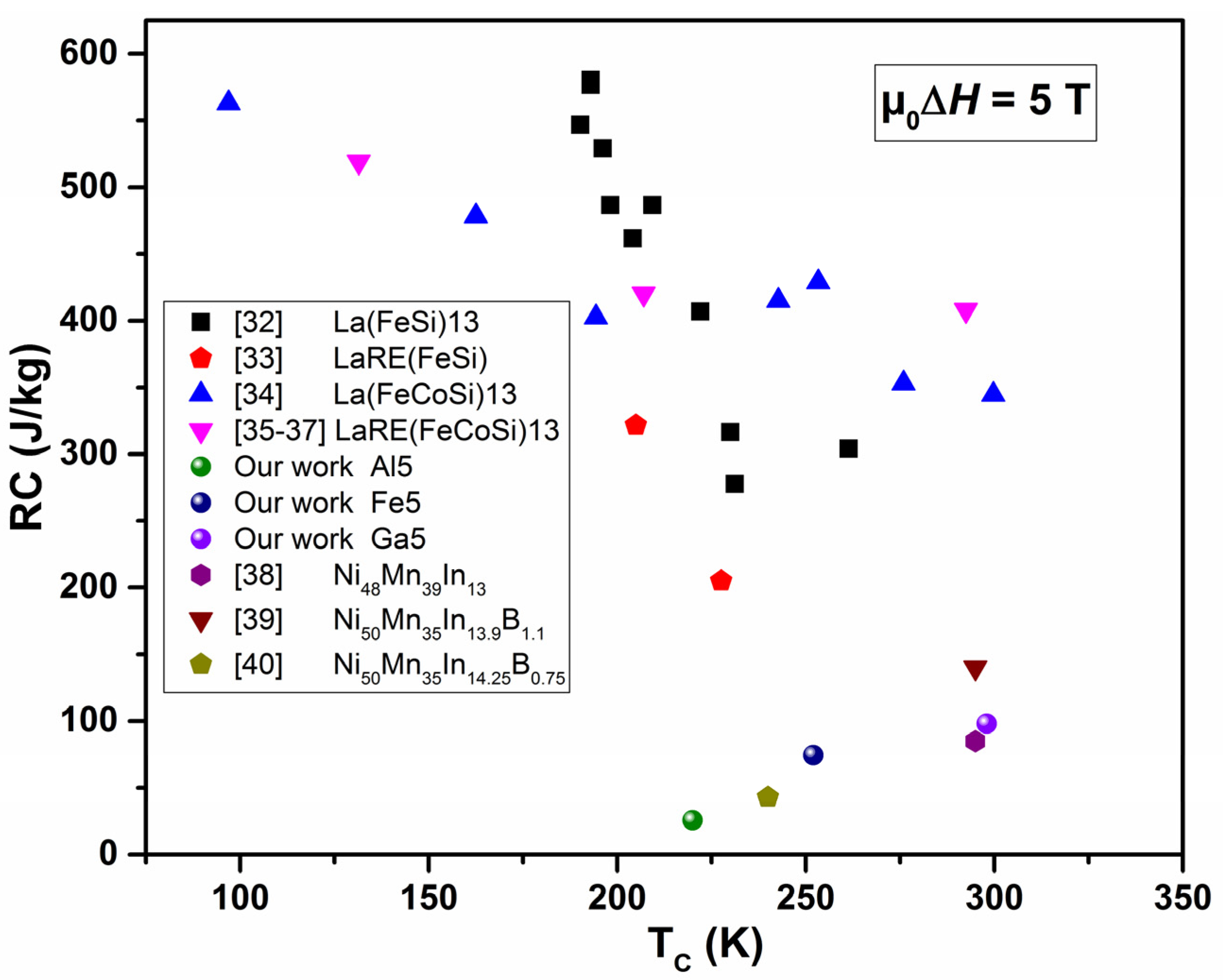Structural, Magnetocaloric, and Magnetic Properties in Heusler Ni50Mn35In10X5 (X = Ga, Fe and Al) Alloys
Abstract
:1. Introduction
2. Materials and Methods
3. Results and Discussion
4. Conclusions
Author Contributions
Funding
Data Availability Statement
Conflicts of Interest
References
- Bachaga, T.; Zhang, J.; Khitouni, M.; Suñol, J.J. NiMn-based Heusler magnetic shape memory alloys: A review. Int. J. Adv. Manuf. Technol. 2019, 103, 2761–2772. [Google Scholar] [CrossRef]
- Zhang, R.; Sun, D.; Ji, C.; Chen, Y.; Zhang, X.; Dong, Z. Shape memory effect and martensitic transformation in Fe–Mn–Al–Ni Alloy. Metals 2022, 12, 247. [Google Scholar] [CrossRef]
- Liao, X.Q.; Wang, Y.; Wetterskog, E.; Cheng, F.; Hao, C.X.; Khan, M.T.; Zheng, Y.Z.; Yang, S. Superposition of conventional and spontaneous exchange bias in a Ni50Mn34In13Fe3 magnetic shape memory alloy. J. Alloys Comp. 2019, 772, 988–993. [Google Scholar] [CrossRef]
- Marchenkov, V.V.; Emelyanova, S.M.; Marchenkova, E.B. Martensitic transformation temperatures and Hall effect in Ni47−xMn41+xIn12 (x = 0, 1, 2) Alloys. Materials 2023, 16, 672. [Google Scholar] [CrossRef] [PubMed]
- Tavares, S.; Yang, K.; Meyers, M.A. Heusler alloys: Past, properties, new alloys, and prospects. Prog. Mater. Sci. 2023, 132, 101017. [Google Scholar] [CrossRef]
- Konoplyuk, S.; Kolomiets, A.; Prokleska, J.; Proschek, P.; Buturlim, V.; Gerstein, G.; Jürgen Maier, H. Pressure and magnetic field-induced transport effects in Ni45.4Mn40In14.6 alloy. Phys. Scr. 2021, 96, 125833. [Google Scholar] [CrossRef]
- Bachaga, T.; Daly, R.; Escoda, L.; Suñol, J.J.; Khitouni, M. Influence of chemical composition on martensitic transformation of MnNiIn shape memory alloys. J. Therm. Anal. Cal. 2015, 122, 167–173. [Google Scholar] [CrossRef]
- Sivaprakash, P.; Kim, I.; Divya, S.; Hajra, S.; Hwan Oh, T.; Esakki Muthu, S. Influence of non-magnetic Cu on structural, magnetic and magnetocaloric properties on NiMnIn bulk Heusler alloys. Mater. Sci. Eng. B 2023, 297, 116760. [Google Scholar] [CrossRef]
- Blinov, M.; Aryal, A.; Pandey, S.; Dubenko, I.; Talapatra, S.; Prudnikov, V.; Lähderanta, E.; Stadler, S.; Buchelnikov, V.; Sokolovskiy, V.; et al. Effects of magnetic and structural phase transitions on the normal and anomalous Hall effects in Ni-Mn-In-B Heusler alloys. Phys. Rev. B 2020, 101, 094423. [Google Scholar] [CrossRef]
- Pathak, A.K.; Dubenko, I.; Karaca, H.E.; Stadler, S.; Ali, N. Large inverse magnetic entropy changes and magnetoresistance in the vicinity of a field-induced martensitic transformation in Ni50−xCoxMn32−yFeyGa18. Appl. Phys. Lett. 2010, 97, 450. [Google Scholar] [CrossRef]
- Krenke, T.; Acet, M.; Wassermann, E.F.; Moya, X.; Vila, A.P. Ferromagnetism in the austenitic and martensitic states of Ni-Mn-In alloys. Phys. Rev. B 2006, 73, 174413. [Google Scholar] [CrossRef]
- Suñol, J.J.; Escoda, L.; Hernando, B.; Llamazares, J.L.S.; Prida, V.M. Structural behavior of Ni-Mn-(In, Sn) Heusler melt spun ribbons. EDP Sci. 2009, 02031. [Google Scholar] [CrossRef]
- Bachagha, T.; Ren, W.; Suñol, J.J.; Jing, C. Microstructure characterization, structure and magnetic properties of Ni–Mn–Sn shape memory alloys. J. Therm. Analy Cal. 2022, 147, 2147–2154. [Google Scholar] [CrossRef]
- Bachagha, T.; Suñol, J.J. All-d-metal Heusler alloys: A review. Metals 2023, 13, 111. [Google Scholar] [CrossRef]
- Llamazares, J.; Sanchez, T.; Santos, J.D.; Perez, M.J.; Sanchez, M.L.; Hernando, B.; Escoda, L.; Suñol, J.J.; Varga, R. Martensitic phase transformation in rapidly solidified Mn50Ni40In10 alloy ribbons. Appl. Phys. Lett. 2008, 92, 4358. [Google Scholar]
- Yan, F.; Yuan, X.; Zhou, M.; Gao, L. Improvement of mechanical properties and magnetocaloric effect in Ag doped Ni-Mn-In magnetic shape memory alloys. J. Alloys Comp. 2023, 944, 169143. [Google Scholar]
- Camarillo-Garcia, J.P.; Hernández-Navarro, P.; Flórez-Zúñiga, H.; Baltazar-Hernández, V.H.; Alvarado-Hernández, F. Contrasting response on magnetocaloric effect and refrigeration capacity dur to Ni or Mn substitution by Fe in Ni-Mn-In-Co-Fe alloy. J. Alloys Comp. 2022, 934, 167852. [Google Scholar] [CrossRef]
- Feng, Y.; Gao, J.; Zhou, M.; Wang, H. Giant magnetocaloric effect induced by lower stress in Ni-Mn-In-Fe ferromagnetic shape memory alloys. J. Magn. Magn. Mater. 2022, 563, 169906. [Google Scholar] [CrossRef]
- Lutterotti, L.; Matthies, S.; Wenk, H. MAUD: A friendly Java program for material analysis using diffraction. IUCr Newsl. CPD 1999, 21, 14–15. [Google Scholar]
- Zhang, C.L.; Shi, H.F.; Ye, E.J.; Nie, Y.G.; Han, Z.D.; Qian, B.; Wang, D.H. Magnetostructural transition and magnetocaloric effect in MnNiSi-Fe2Ge system. Appl. Phys. Lett. 2015, 107, 020401–020439. [Google Scholar] [CrossRef]
- Chen, J.H.; Trigg, A.; Chhetri, T.P.; Young, D.P.; Stadler, S. The influence of Au substitution and hydrostatic pressure on the phase transitions and magnetocaloric properties of MnCoGe alloys. J. Appl. Phys. 2020, 127, 213901. [Google Scholar] [CrossRef]
- Aryal, A.; Quetz, A.; Pandey, S.; Dubenko, I.; Stadler, S.; Ali, N. Effect of Bi substitution on the magnetic and magnetocaloric properties of Ni50Mn35In15−xBix Heusler alloys. AIP Adv. 2017, 8, 056409. [Google Scholar] [CrossRef]
- Pathak, A.K.; Khan, M.; Gautam, B.R.; Stadler, S.; Dubenko, I.; Ali, N. Exchange bias in bulk Ni–Mn–In-based Heusler alloys. J. Magn. Magn. Mater. 2009, 321, 963–965. [Google Scholar] [CrossRef]
- Quetz, A.; Mucharla, B.; Samanta, T.; Dubenko, I.; Talapatra, S.; Stadler, S.; Ali, N. Phase diagram and magnetocaloric effects in Ni50Mn35(In1−xCrx)15 and (Mn1−xCrx)NiGe1.05 alloys. J. Appl. Phys. 2014, 115, 4722. [Google Scholar] [CrossRef]
- Chen, J.; Bruno, N.M.; Karaman, I.; Huang, Y.; Li, J.; Ross, J., Jr. Direct measure of giant magnetocaloric entropy contributions in Ni–Mn–In. J. Alloys Compds. 2016, 105, 176–181. [Google Scholar] [CrossRef]
- Pathak, A.K.; Dubenko, I.; Pueblo, C.; Stadler, S.; Ali, N. Magnetoresistance and magnetocaloric effect at a structural phase transition from a paramagnetic martensitic state to a paramagnetic austenitic state in Ni50Mn36.5In13.5 Heusler alloys. Appl. Phys. Lett. 2010, 96, 945. [Google Scholar] [CrossRef]
- Llamazares, J.; Flores-Zuiga, H.; Sánchez-Valdes, C.; Ross, C.; García, C. Refrigerant capacity of austenite in as-quenched and annealed Ni51.1Mn31.2In17.7 melt spun ribbons. J. Appl. Phys. 2012, 111, 927–932. [Google Scholar]
- Mha, B.; Lgb, C.; Rvb, C. Study of martensitic transition temperature on Ni54Fe19Ga23X4 Heusler glass-coated microwires doped by X = B, Al, Ga, In. J. Magn. Magn. Mater. 2022, 542, 168605. [Google Scholar]
- Caron, L.; Ou, Z.Q.; Nguyen, T.T.; Thanh, D.; Tegus, O.; Brück, E. On the determination of the magnetic entropy change in materials with first-order transitions. J. Magn. Magn. Mater. 2009, 321, 3559–3566. [Google Scholar] [CrossRef]
- Aksoy, S.; Krenke, T.; Acet, M.; Wassermann, E.F.; Moya, X.; Manosa, L.; Planes, A. Tailoring magnetic and magnetocaloric properties of martensitic transitions in ferromagnetic Heusler alloys. Appl. Phys. Lett. 2007, 91, 241916. [Google Scholar] [CrossRef]
- Gschneidnerjr, K.A.; Pecharsky, V.K.; Tsokol, A.O. Recent developments in magnetocaloric materials. Rep. Prog. Phys. 2005, 68, 1479–1539. [Google Scholar] [CrossRef]
- Jia, L.; Sun, J.R.; Shen, J.; Dong, Q.Y.; Zou, J.D.; Gao, B.; Zhao, T.Y.; Zhang, H.W.; Hu, F.X.; Shen, B.G. Magnetocaloric effects in the La(Fe,Si)13 intermetallics doped by different elements. J. Appl. Phys. 2009, 105, 3675. [Google Scholar] [CrossRef]
- Zhang, H.; Long, Y.; Cao, Q.; Zou, M.; Gschneidner, K.A.; Pecharsky, V.K. Effect of Ca on the Microstructure and Magnetocaloric Effects in the La1−xCaxFe11.5Si1.5 Compounds. Chem. Inform. 2011, 42, 3746–3750. [Google Scholar] [CrossRef]
- Zhang, H.; Shen, J.; Xu, Z.; Zheng, X.; Hu, F.; Sun, J.; Shen, B. Simultaneous enhancements of Curie temperature and magnetocaloric effects in the La1−xCexFe11.5Si1.5Cy compounds. J. Magn. Magn. Mater. 2012, 324, 484–487. [Google Scholar] [CrossRef]
- Patissier, A.; Paul-Boncour, V. Fast synthesis of LaFe13−xSix magnetocaloric compounds by reactive Spark Plasma Sintering. J. Alloy Compds. 2015, 645, 143–150. [Google Scholar] [CrossRef]
- Balli, M.; Fruchart, D.; Gignoux, D. Optimization of La(Fe,Co)13−xSix based compounds for magnetic refrigeration. J. Phys. Cond. Matt. 2007, 19, 236230. [Google Scholar] [CrossRef]
- Kumar, P.; Lyubina, J.; Gutfleisch, O. Magnetic and magnetocaloric effect in melt spun La1−xRxFe13−yAlyCz (R = Pr and Nd) compounds. J. Phys. D 2009, 42, 205003–205008. [Google Scholar] [CrossRef]
- Pandey, S.; Quetz, A.; Aryal, A.; Dubenko, I.; Mazumdar, D. Magnetocaloric, thermal, and magnetotransport properties of Ni50Mn35In13.9B1.1 Heusler alloy. J. Magn. Magn. Mater. 2017, 444, 98–101. [Google Scholar] [CrossRef]
- Pandey, S.; Quetz, A.; Ibarra-Gaytan, P.J.; Sánchez-Valdés, C.F.; Aryal, A.; Dubenko, I.; Sanchez Llamazares, J.L.; Stadler, S.; Ali, N. Magnetostructural transitions and magnetocaloric effects in Ni50Mn35In14.25B0.75 ribbons. AIP Adv. 2018, 8, 056434. [Google Scholar] [CrossRef]
- Zhao, X.G.; Hsieh, C.C.; Lai, J.H.; Cheng, X.J.; Chang, W.C.; Cui, W.B.; Liu, W.; Zhang, Z.D. Effects of annealing on the magnetic entropy change and exchange bias behavior in melt-spun Ni–Mn–In ribbons. Scr. Mater. 2010, 63, 250–253. [Google Scholar] [CrossRef]
- Venkatesan, S.; Kavita, S.; Perumal, S. Structure stability driven large magnetocaloric response in Ni-Co-Mn-In-Si Heusler alloy. Ceram. Int. 2022, 48, 29059–29066. [Google Scholar] [CrossRef]
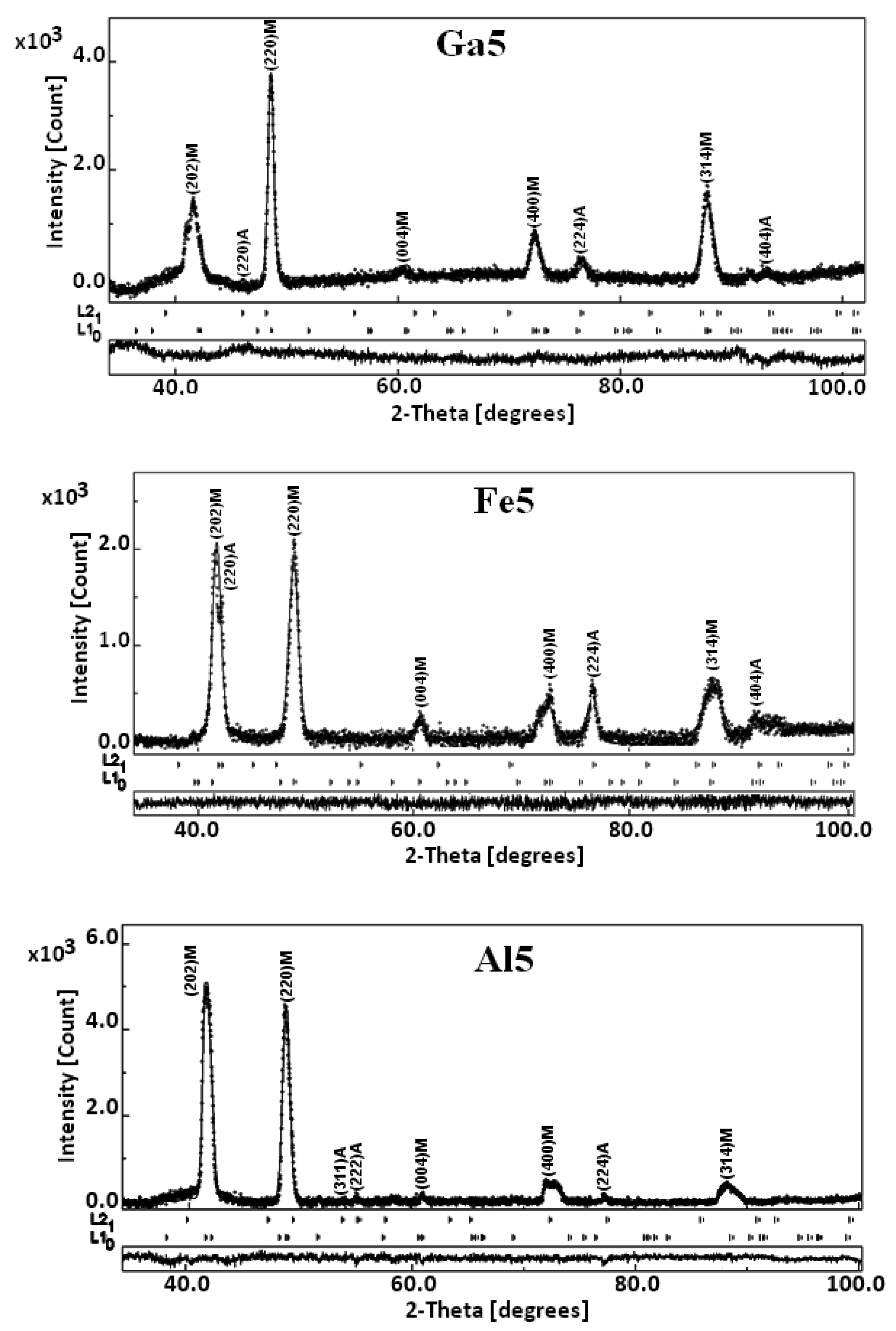
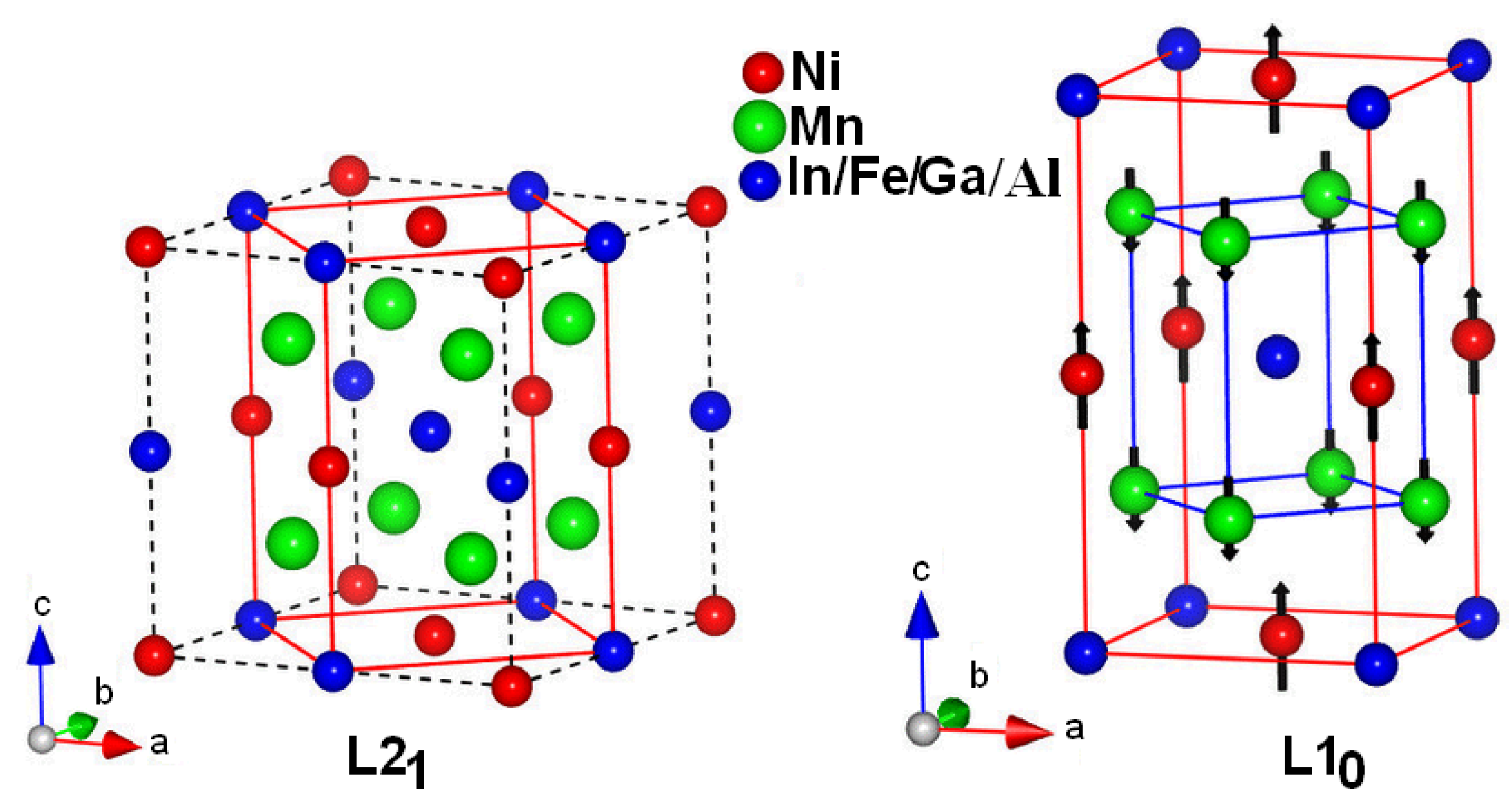
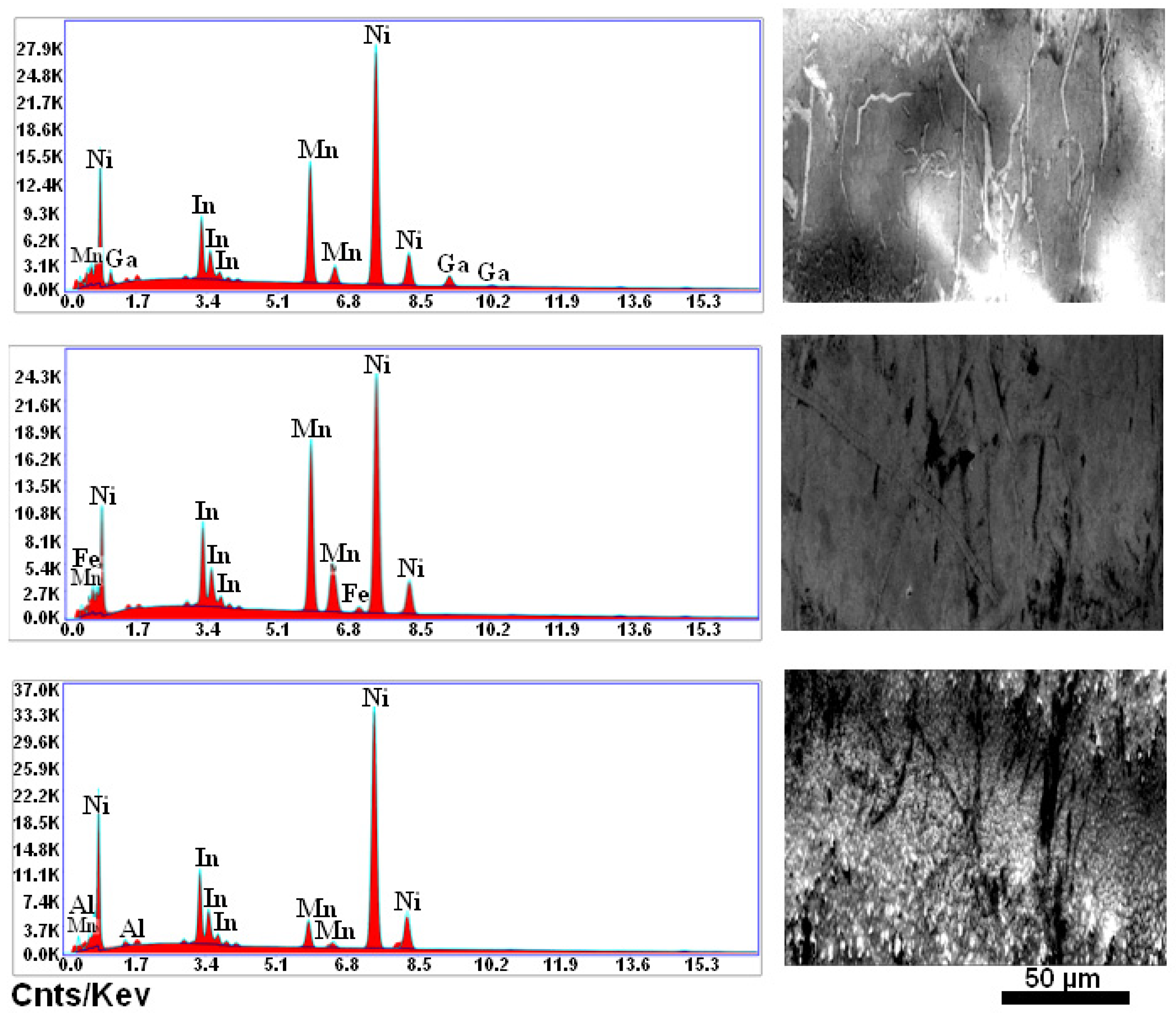

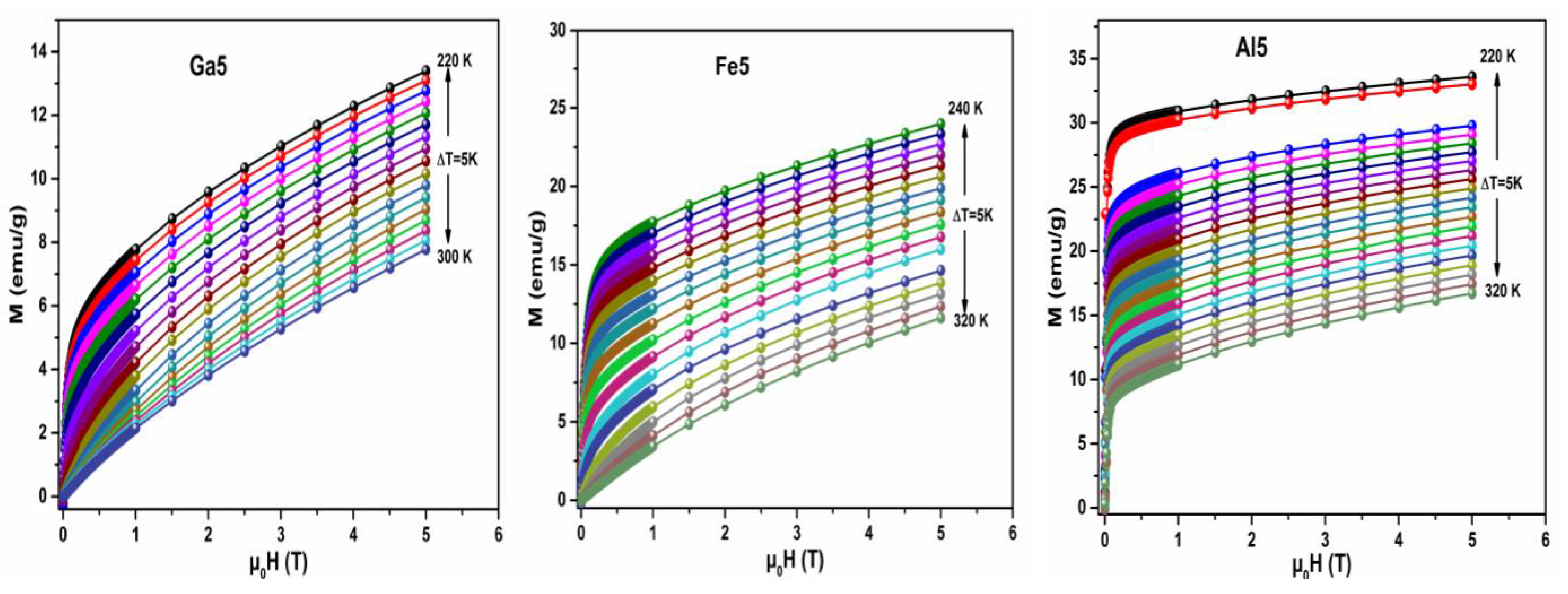


Disclaimer/Publisher’s Note: The statements, opinions and data contained in all publications are solely those of the individual author(s) and contributor(s) and not of MDPI and/or the editor(s). MDPI and/or the editor(s) disclaim responsibility for any injury to people or property resulting from any ideas, methods, instructions or products referred to in the content. |
© 2023 by the authors. Licensee MDPI, Basel, Switzerland. This article is an open access article distributed under the terms and conditions of the Creative Commons Attribution (CC BY) license (https://creativecommons.org/licenses/by/4.0/).
Share and Cite
Bachagha, T.; Chakaravarthy, R.; Ren, W.; Saurina, J.; Suñol, J.-J. Structural, Magnetocaloric, and Magnetic Properties in Heusler Ni50Mn35In10X5 (X = Ga, Fe and Al) Alloys. Metals 2023, 13, 1913. https://doi.org/10.3390/met13121913
Bachagha T, Chakaravarthy R, Ren W, Saurina J, Suñol J-J. Structural, Magnetocaloric, and Magnetic Properties in Heusler Ni50Mn35In10X5 (X = Ga, Fe and Al) Alloys. Metals. 2023; 13(12):1913. https://doi.org/10.3390/met13121913
Chicago/Turabian StyleBachagha, Tarek, Ramki Chakaravarthy, Wei Ren, Joan Saurina, and Joan-Josep Suñol. 2023. "Structural, Magnetocaloric, and Magnetic Properties in Heusler Ni50Mn35In10X5 (X = Ga, Fe and Al) Alloys" Metals 13, no. 12: 1913. https://doi.org/10.3390/met13121913
APA StyleBachagha, T., Chakaravarthy, R., Ren, W., Saurina, J., & Suñol, J.-J. (2023). Structural, Magnetocaloric, and Magnetic Properties in Heusler Ni50Mn35In10X5 (X = Ga, Fe and Al) Alloys. Metals, 13(12), 1913. https://doi.org/10.3390/met13121913







